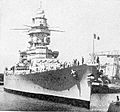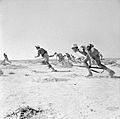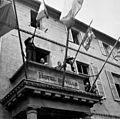Free French Forces facts for kids
The Free French Forces were a group of French soldiers and people who kept fighting against Nazi Germany during World War II. They formed in 1940 after Germany occupied France. Their goal was to free France from enemy control. They played a big part in weakening the German army until France was liberated in 1944.
Contents
What Were the Free French Forces?
After France was defeated by Germany in 1940, a new French government was set up that worked with the Germans. However, many French people refused to give up. Led by General Charles de Gaulle, they formed the Free French Forces. They continued the fight from outside France, mainly from London, England.
Starting the Fight
General de Gaulle made a famous radio speech from London on June 18, 1940. He called on all French people to resist and join him. This speech became known as the Appeal of 18 June. It marked the official start of the Free French movement. Many soldiers, sailors, and airmen who were outside France joined him.
Fighting Around the World
The Free French Forces fought in many places, not just France. They took part in battles in Africa, the Middle East, and even in the Pacific Ocean. They helped the Allied forces (like Britain and the United States) in important campaigns.
Key Battles and Contributions
- North Africa: Free French troops fought in North Africa, helping to push German and Italian forces out of the region.
- Syria and Lebanon: They also helped liberate Syria and Lebanon from control by the pro-German French government.
- Battle of Bir Hakeim: In 1942, Free French soldiers bravely defended Bir Hakeim in North Africa. They held off a much larger German force for days, which helped the Allies win a major battle at El Alamein. This showed their courage and skill.
- Air and Naval Forces: The Free French also had their own air force and navy. Their pilots fought in the Battle of Britain, and their submarines and ships helped protect Allied convoys and attack enemy vessels.
The French Resistance
Inside France, many people formed secret groups called the French Resistance. They worked with the Free French Forces outside the country. The Resistance carried out many dangerous missions. They sabotaged German railways, gathered information, and helped Allied pilots who had been shot down. This secret fight was very important for weakening the German hold on France.
Towards Liberation
As the war continued, the Free French Forces grew stronger. In 1943, they joined with other French forces in North Africa to form the French Committee of National Liberation. This group became the official government of Free France.
D-Day and the Liberation of Paris
In June 1944, the Allies launched the D-Day invasion to free France. Free French soldiers fought alongside American, British, and Canadian troops. General de Gaulle's forces played a key role in the final push. On August 25, 1944, the Liberation of Paris took place. Free French troops were among the first to enter the city, marking a huge victory.
Legacy of the Free French Forces
The Free French Forces showed the world that France would not give up. They helped restore France's honor and its place among the Allied nations. After the war, General de Gaulle became a very important leader in France. The spirit of the Free French continues to be a symbol of courage and determination.
Images for kids
-
Charles de Gaulle was an armoured division commander and a minister in the Reynaud government during the Battle of France.
-
In Occupied France during the war, reproductions of the 18 June appeal were distributed through underground means as pamphlets and plastered on walls as posters by supporters of the Résistance. This could be a dangerous activity.
-
Emile Fayolle, pilot of the Free French Air Force, during the Battle of Britain
-
A very modern Dunkerque-class battleship commissioned in 1937, Strasbourg was potentially a quite substantial threat to British control of the sealanes were she to fall into Axis hands.
-
Insigna of the Free French Forces in the Far East (French Indochina), Langlade Mission
-
The fall of Damascus to the Allies, late June 1941. A car carrying Free French commanders General Georges Catroux and General Paul Louis Le Gentilhomme enters the city, escorted by French Circassian cavalry (Gardes Tcherkess).
-
The FFF's tenacious defence at Bir Hakeim prevented Rommel's attempted flanking manoeuvre at El Alamein from succeeding.
-
Operation Torch landings in Morocco and Algeria
-
Henri Giraud and de Gaulle during the Casablanca Conference in January 1943. Churchill and Roosevelt are in the background.
-
FAFL Normandie-Niemen Yak-3 preserved at the Paris Le Bourget museum
-
Charles de Gaulle speaks as president of interim government to the population of Cherbourg from the city hall's balcony on 20 August 1944
-
The Western Front in 1944
-
Leclerc's 2nd Armoured Division (2e DB) parading down the Champs Elysées on 26 August 1944, the day after the Liberation of Paris
-
A plaque commemorating the Oath of Kufra in near the cathedral of Strasbourg




















